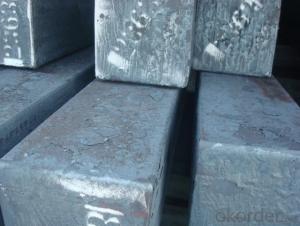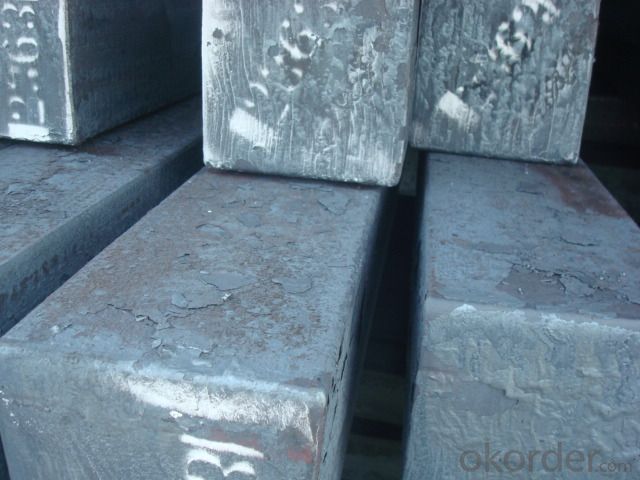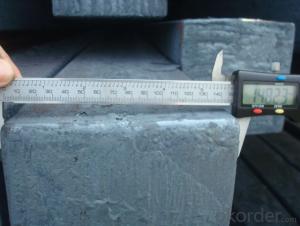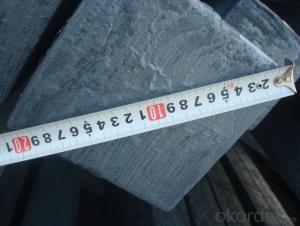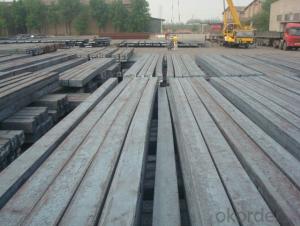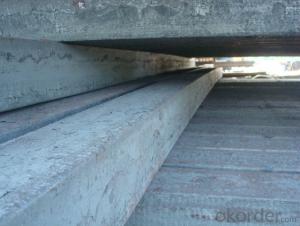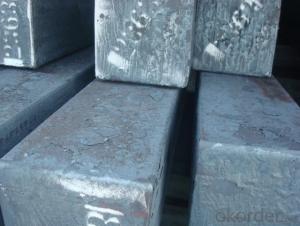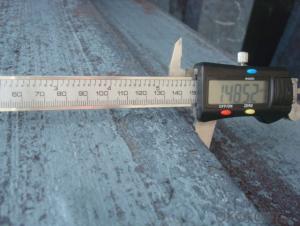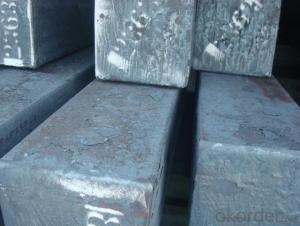Continue Casting Steel Billet by Blast Furnace
- Loading Port:
- Tianjin
- Payment Terms:
- TT OR LC
- Min Order Qty:
- 25 m.t.
- Supply Capability:
- 10000 m.t./month
OKorder Service Pledge
OKorder Financial Service
You Might Also Like
Continue Casting Steel Billet by Blast Furnace
1.Structure of Continue Casting Steel Billet by Blast Furnace
Continue casting steel billet by blast furnace is the raw material of all kinds of steel mill. Billet section of square, round, flat, rectangular and abnormity, etc Several, mainly related to shape of rolled products. Simple rolled section steel, choose cross section of square billet or rectangular billet. rolling The sector products such as flat steel, Angle steel, select the rectangular billet or slab. Had better profiled billet when production beams, channels, and in rolling process Lines and improve the yield. The raw material of round billet is the production of seamless tube.
2.Main Features of Continue Casting Steel Billet by Blast Furnace.
Continue Casting Steel Billet by Blast Furnace section size should meet the requirements of rolling deformation and finished product quality, but also roll strength and biting condition of restrictions. General steel Billet section height H. And the roll diameter D The ratio of the ( namely H/D) Should be less than or equal to zero 0.5 . Length of steel billet by finishing temperature, Rolling time and the length of the product Or times ruler. When heated too long accident prone to bump the furnace wall of steel, too short, furnace bottom utilization rate is not high, influence the heating furnace production. For the production Choose a variety of steel and steel billet, should consider the affinities of billet, as far as possible in order to improve the productivity of the roughing mill, simplify the stock management of workshop.
3. Continue Casting Steel Billet by Blast Furnace Images
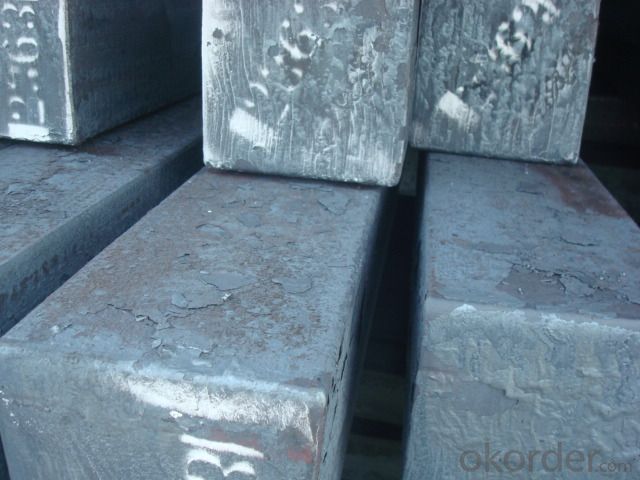
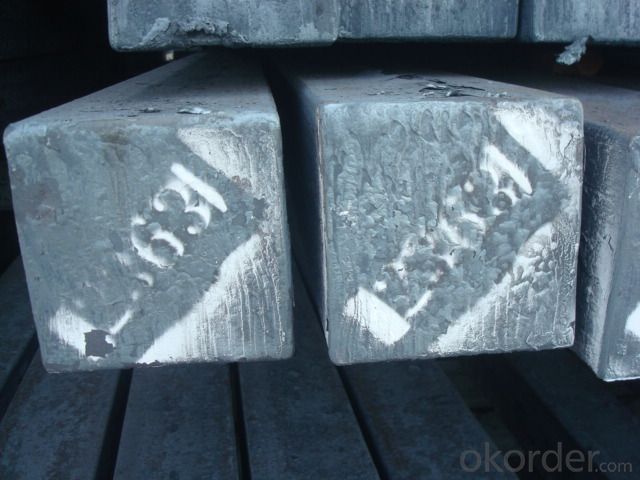
4. Continue Casting Steel Billet by Blast Furnace Specification
Continue Casting Steel Billet by Blast Furnace rolled steel, after processing can be used for mechanical parts, forging parts, processing all kinds of steel, steel Q345B channel steel, wire rod is the role of the billet. Steel billet is used in the production of semi-finished products, generally cannot be used directly for the society. Steel billets and steel are strictly divided into standard, cannot decide to whether the business enterprise of the final product, and according to unified standards to perform the whole society. Typically, billet and the steel is relatively easy to distinguish, but for some steel billet, and have the same specification and same steel purposes (such as rolling tube billet), whether can be used for other industries, whether through steel processing process, whether through a finished product rolling mill processing to distinguish
Material standard The editor Range of thickness: 150-240 - mm + / - 5 mm width range: 880-1530 - mm + / - 20 mm Length: 3700-10000 - mm + / - 500 - mm Cross-sectional size: 64 * 64; 82 * 82; 98 * 98; 124 * 124; 120 * 150; 152 * 164; 152 * 170 mm Length: 9000 mm Section of tolerance: billet: 1.0 + / - 2.0-1.0 + / - 1.0 mm slab: width: + / - 2.0 mm thickness: + / - 3.0 mm The length tolerance: + / - 200 mm Section diagonal tolerance: 3.5-8.0 MM Billet section size protrusions requirements: < 1242 mm, do not allow; > = 1242 mm, < = 2 mm 1242 mm, < = 3 mm Beheading (shear) extension deformation: < 1242 mm billet: no control; The slab: < = 15 mm Surface tilt: no more than billet section 0.1 Bending: every 1 m length is not more than 10 mm The distortion: length < = 5 m, < = 11. ; The length of the < = 7.5 M, < = 5. Material % 3 sp/PS chemical composition: C Mn Si S P
5.FAQ of Continue Casting Steel Billet by Blast Furnace
We have organized several common questions for our clients,may help you sincerely:
①How about your company?
A world class manufacturer & supplier of castings forging in carbon steel and alloy steel,is one of the large-scale professional investment casting production bases in China,consisting of both casting foundry forging and machining factory. Annually more than 8000 tons Precision casting and forging parts are exported to markets in Europe,America and Japan. OEM casting and forging service available according to customer’s requirements.
②How to guarantee the quality of the products?
We have established the international advanced quality management system,every link from raw material to final product we have strict quality test;We resolutely put an end to unqualified products flowing into the market. At the same time, we will provide necessary follow-up service assurance.
③How is the packaging and delivery?
Exporting Package with the steel material cover and the delivery term is based on the project.
- Q: How are steel billets transported and stored?
- In order to guarantee the quality and safety of steel billets, a careful and systematic approach is typically employed in their transportation and storage. In terms of transportation, trucks and railcars are commonly utilized for moving steel billets. Trucks are frequently used for short distances within a steel mill or between different facilities, while railcars are preferred for longer distances, including intercity or even international transport. To load the steel billets onto trucks or railcars, cranes or forklifts are utilized. It is of utmost importance to properly secure the billets to prevent any movement or damage during transit. Straps, chains, or other securing methods are employed to maintain the billets in position and ensure their stability. Once the steel billets arrive at their destination, similar lifting equipment is used to unload them. It is crucial to handle the billets with caution during the unloading process to prevent any scratches or dents that could compromise their structural integrity. In terms of storage, designated areas known as billet yards or billet storage facilities are typically used for housing steel billets. These areas are specifically designed to accommodate the size and weight of the billets and provide easy access for loading and unloading operations. Steel billets are often stored in stacks or piles, with each billet being carefully positioned to maintain stability and prevent any potential accidents. The billets may be organized based on various criteria, such as size, grade, or production date, in order to facilitate their retrieval when necessary. To protect the billets from environmental factors such as humidity or corrosion, they are often coated with protective coatings or stored in enclosed areas with controlled climate conditions. Additionally, regular inspections and maintenance are conducted to ensure the quality and integrity of the stored billets. In conclusion, proper procedures for transportation and storage are crucial for safeguarding steel billets and preserving their quality until they are ready for further processing or use in various industries.
- Q: How do steel billets compare to other types of metal billets?
- Steel billets generally have several advantages over other types of metal billets. Firstly, steel is known for its strength and durability, making steel billets a reliable choice for various applications. Steel billets also have excellent heat and corrosion resistance, enhancing their longevity and performance. Additionally, steel billets offer a wide range of alloying possibilities, allowing for customization and the creation of specific properties for different applications. Overall, the superior strength, durability, and versatility of steel billets make them a preferred choice in many industries compared to other types of metal billets.
- Q: How do steel billets differ from steel bars?
- Steel billets and steel bars, two intermediate steel products utilized in various industries for further processing, exhibit distinct differences. 1. Shape: Steel billets typically assume square or rectangular shapes, with cross-sectional dimensions ranging from a few inches to several feet. They are typically manufactured through continuous casting or hot rolling procedures. Conversely, steel bars adopt cylindrical shapes and maintain a uniform diameter throughout their length. They are usually produced through hot rolling or cold drawing processes. 2. Size: Steel billets tend to be larger compared to steel bars. Billets can measure from a few feet to several meters in length, while their cross-sectional dimensions can be customized based on the final product's requirements. Conversely, steel bars are typically manufactured in standardized sizes and lengths, such as 6 meters or 12 meters, and possess consistent diameters. 3. Production process: Steel billets are commonly generated through continuous casting or hot rolling methods. Continuous casting involves pouring molten steel into a mold, resulting in a solid billet. Hot rolling, on the other hand, entails passing the billet through multiple rollers to reduce its cross-sectional dimensions. In contrast, steel bars are produced through hot rolling or cold drawing processes. Hot rolling involves guiding billets through a series of rollers to achieve the desired shape and size, while cold drawing requires pulling the hot rolled bars through a die to further reduce their diameter and enhance their surface finish. 4. Applications: Steel billets primarily serve as raw materials for subsequent processing into various steel products, such as bars, rods, wires, and tubes. Additionally, they find application in the forging industry for the production of forged components. Steel bars, in contrast, enjoy a wide range of applications in construction, manufacturing, infrastructure, and automotive industries. They are commonly employed as reinforcement in concrete structures and in the production of shafts, gears, axles, and other machine parts. To summarize, steel billets and steel bars differ in terms of shape, size, production process, and applications. Billets, with their larger size and square or rectangular shape, serve as raw materials for further processing. Meanwhile, bars, with their cylindrical form and consistent diameter, find application in various industries for specific purposes.
- Q: What is the global production and consumption of steel billets?
- The global production and consumption of steel billets vary each year based on market demand and economic factors. However, steel billets are a crucial raw material in the steel industry, used for further processing into various steel products. The production and consumption of steel billets are significant in countries with a robust steel industry, such as China, India, the United States, and Russia. Accurate figures for global production and consumption can be obtained from industry reports and statistical data provided by organizations like the World Steel Association.
- Q: How are steel billets used in the production of reinforcement bars?
- Steel billets are the primary raw material used in the production of reinforcement bars. These billets are heated and then passed through a series of rolling mills to shape them into the desired size and shape of reinforcement bars. The rolling process also helps in improving the mechanical properties and strength of the bars. Once the bars are formed, they undergo further processes such as quenching and tempering to enhance their strength and durability. Overall, steel billets play a crucial role in the production of reinforcement bars by serving as the starting material and undergoing various manufacturing processes to produce high-quality bars used in construction and infrastructure projects.
- Q: How are steel billets used in the manufacturing of hydraulic equipment?
- Steel billets are an essential component in the manufacturing process of hydraulic equipment. These billets, which are essentially semi-finished steel forms, play a crucial role in the production of hydraulic components such as cylinders, valves, and pumps. Firstly, steel billets are carefully selected based on their composition and quality. The properties of the steel, such as its strength, ductility, and resistance to corrosion, are important considerations in ensuring the durability and performance of hydraulic equipment. Once the suitable steel billets are obtained, they undergo a series of manufacturing processes to transform them into the desired hydraulic components. For example, the billets may be heated and then forged or extruded to shape them into cylinders or valve bodies. This shaping process helps to achieve the required dimensions, smooth surfaces, and structural integrity. In addition to shaping, steel billets may also undergo machining operations, such as drilling or milling, to create precise holes and intricate features on the hydraulic components. This ensures proper fluid flow and functionality of the equipment. Furthermore, steel billets can be heat-treated to enhance their mechanical properties. Annealing, quenching, or tempering processes may be applied to achieve specific hardness, toughness, or elasticity characteristics, depending on the requirements of the hydraulic equipment. Overall, steel billets serve as the raw material for the manufacturing of hydraulic equipment, providing the necessary strength, durability, and versatility required for these critical components. Their careful selection, shaping, machining, and heat treatment contribute to the production of high-quality hydraulic equipment that can withstand the demanding conditions and pressures of various industrial applications.
- Q: How are steel billets used in the manufacturing of automotive parts?
- Steel billets are used in the manufacturing of automotive parts by being heated and shaped into various forms such as rods, bars, and sheets. These billets serve as the raw material for forging, casting, and machining processes, enabling the production of critical components like engine blocks, crankshafts, suspension systems, and chassis. The high strength and durability of steel make it an ideal choice for automotive applications, ensuring the safety and performance of vehicles.
- Q: Can steel billets be used for artistic purposes?
- Absolutely, steel billets have the potential to be utilized for artistic purposes. Although steel billets are typically employed as raw materials for industrial applications such as construction or manufacturing, they can also be artfully transformed into exquisite pieces. Sculptures, decorative items, and even functional objects like furniture can all be crafted from steel billets by artists. The malleability of steel allows artists to shape and mold it into various forms, and its robustness and longevity ensure that the artwork will endure. Additionally, the metallic appearance of steel can infuse artistic creations with a contemporary and industrial aesthetic. All in all, steel billets offer artists a distinctive medium to unleash their creativity and produce visually stunning works.
- Q: What is the role of steel billets in the manufacturing of railway wheels?
- Steel billets play a crucial role in the manufacturing of railway wheels. They serve as the primary raw material used to create these wheels. Railway wheels need to be extremely strong, durable, and able to withstand heavy loads, extreme temperatures, and constant wear and tear. Steel billets are first melted down and then shaped into a cylindrical form, which is similar to the final shape of the railway wheel. These billets are then further processed through a series of manufacturing steps, such as hot rolling, forging, and machining, to transform them into the desired shape and dimensions of the railway wheel. The main advantage of using steel billets is their high strength and toughness. Steel is renowned for its excellent mechanical properties, including high tensile strength and hardness. These characteristics are essential for railway wheels, as they need to bear enormous loads and resist deformation under extreme pressures. Moreover, steel billets provide the necessary metallurgical properties required for railway wheels. They can be alloyed with additional elements such as carbon, manganese, and chromium to enhance their strength, hardness, and resistance to corrosion and fatigue. This ensures that the railway wheels maintain their structural integrity and performance over an extended period of time. In summary, steel billets are the starting point in the manufacturing process of railway wheels. They provide the raw material necessary to create robust, durable, and reliable wheels that can withstand the demanding conditions of railway operations. The use of steel billets ensures that railway wheels meet the stringent requirements for safety, performance, and longevity in the transportation industry.
- Q: What industries use steel billets?
- Several industries use steel billets, including automotive, construction, manufacturing, and infrastructure. Steel billets are commonly used as raw material in the production of various metal products such as pipes, rods, bars, wires, and sheets. They are also utilized in the construction of bridges, buildings, and other structural components. The automotive industry uses steel billets for manufacturing parts like engine blocks, chassis, and suspension components. Additionally, steel billets find applications in the energy sector, machinery production, and shipbuilding.
Send your message to us
Continue Casting Steel Billet by Blast Furnace
- Loading Port:
- Tianjin
- Payment Terms:
- TT OR LC
- Min Order Qty:
- 25 m.t.
- Supply Capability:
- 10000 m.t./month
OKorder Service Pledge
OKorder Financial Service
Similar products
Hot products
Hot Searches
Related keywords
